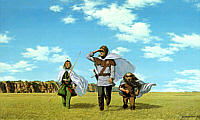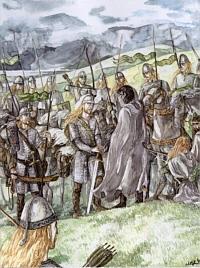TTT: Bk 3, Ch 2
'What news from the north, Riders of Rohan?'Aragorn, Legolas and Gimli cross the western Emyn Muil in pursuit of the Orcs. At this point, they believe they're taking the hobbits to Isengard, but they're not sure by which route. At the edge of the hills, the land slopes down and becomes the East Wall of Rohan leading to the open grassy plains of that land. They descend to the plain and discover the grass trampled. The trail is still fresh, but the Orcs have advanced far ahead, because they travel both by day and night. Along the way, Aragorn spies a leaf-shaped brooch from one of the hobbits' Elven cloaks.
 After journeying straight through for a day and a half, the hunters decide that not only do they need to rest at night, but they could potentially miss an important clue, similar to the brooch, in the darkness. The next morning began their third day of pursuit, ever sustained by the lembas bread they had received in Lothlorien. However, the trail is beginning to show signs of growing cold. The lands before them are empty of both man and beast, which seems strange to Aragorn. They rest again that night. Meanwhile, what the reader does not know is that the Orcs are at that moment running into some problems with their hobbit captives as well as the men of Rohan.
After journeying straight through for a day and a half, the hunters decide that not only do they need to rest at night, but they could potentially miss an important clue, similar to the brooch, in the darkness. The next morning began their third day of pursuit, ever sustained by the lembas bread they had received in Lothlorien. However, the trail is beginning to show signs of growing cold. The lands before them are empty of both man and beast, which seems strange to Aragorn. They rest again that night. Meanwhile, what the reader does not know is that the Orcs are at that moment running into some problems with their hobbit captives as well as the men of Rohan.The next morning, there is a red dawn and Legolas feels it is a sign of some sort. Eventually, they come upon a spot where the Orcs rested. Aragorn estimates the Orcs are about 36 hours ahead of them and likely approached Fangorn Forest as early as the night before. They are beginning to grow weary and pessimistic about their chances of ever catching up to them. They continue on. The next day, the fourth of the journey, Legolas sees a dark shape moving across the plain. It is a band of riders numbering some one hundred and five in strength. While they don't yet know if they are friend or foe, Aragorn knows that they are from Rohan. Whether or not the rumor that the men of Rohan are in league with either Saruman or Sauron is true, they have little choice but to wait for the band to overtake them.
As the sound of galloping hoofs grew louder, the hunters get a closer look at the riders:
"Their horses were of great stature, strong and clean-limbed; their grey coats glistened, their long tails flowed in the wind, their manes were braided on their proud necks. The Men that rode them matched them well: tall and long-limbed; their hair, flaxen-pale, flowed under their light helms, and streamed in long braids behind them; their faces were stern and keen. In their hands were tall spears of ash, painted shields were slung at their backs, long swords were at their belts, their burnished shirts of mail hung down upon their knees."These were the Riders of Rohan; the Rohirrim. In creating this race of men, akin to the Woodland men and Beornings in the North, Tolkien wanted to represent the early Anglo-Saxons or rather how the Anglo-Saxons might have been if not for the Norman Invasion of England in 1066. Tolkien always believed that if these early Britons had horses, a strong cavalry like the Rohirrim, that they could have repulsed William the Conqueror and preserved the culture that existed in the England of the early Middle Ages. Further, according to Tom Shippey, Tolkien's creation of the Rohan was driven by his desire to showcase some of the Old English that he was so fond of. As he explains in The Road To Middle-Earth:
"He wrote the fiction to present the languages, and he did that because he loved them and thought them intrinsically beautiful. Maps, names and languages came before the plot. Elaborating them was in a sense Tolkien's way of building up enough steam to get rolling; but they had also in a sense provided the motive to want to. They were 'inspiration' and 'invention' at once, or perhaps more accurately, by turns."Now Aragorn, Legolas and Gimli find themselves surrounded by the horsemen and staring at the business end of dozens of spears. Here we meet Eomer, son of Eomund and nephew of King Theoden of Rohan. Though we do not find out his name until a little exchange he has with Gimli that I always love. The Dwarf says "Give me your name, horse-master, and I will give you mine, and more besides." The sheer audacity of a four-foot dwarf mouthing off to this tall man with an army behind him was played to the hilt in the film, The Two Towers. Although this incident nearly gets out of control, the tension is soon relieved when upon further discussion, each party is convinced that the other is not allied with dark forces.
Eomer explains that the Orcs they are hunting have been
 destroyed at their hands along the forest-eaves of Fangorn. None were left alive. When Aragorn asks of the hobbits, he reports that he and his men noticed no one but Orcs. While Aragorn reveals their purpose for being in Rohan, he keeps secret the business of the Ring. News of the deaths of both Gandalf and Boromir weigh heavily on Eomer and he is amazed that they have traveled some forty-five leagues in only four days. I note here that for purposes of consistency, Karen Wynn Fonstad, in her book The Atlas of Middle-Earth, uses a standard three miles per league in her maps - which would make their journey about one hundred thirty five miles. Eomer reveals that Rohan was been fueding with Orcs since they stole nine black horses from them several years earlier, obviously for the foul purpose of bearing the Nazgul. In fact, he says, some of the Rohirrim are currently in the midst of battle with them.
destroyed at their hands along the forest-eaves of Fangorn. None were left alive. When Aragorn asks of the hobbits, he reports that he and his men noticed no one but Orcs. While Aragorn reveals their purpose for being in Rohan, he keeps secret the business of the Ring. News of the deaths of both Gandalf and Boromir weigh heavily on Eomer and he is amazed that they have traveled some forty-five leagues in only four days. I note here that for purposes of consistency, Karen Wynn Fonstad, in her book The Atlas of Middle-Earth, uses a standard three miles per league in her maps - which would make their journey about one hundred thirty five miles. Eomer reveals that Rohan was been fueding with Orcs since they stole nine black horses from them several years earlier, obviously for the foul purpose of bearing the Nazgul. In fact, he says, some of the Rohirrim are currently in the midst of battle with them.He also gives the hunters a warning about Saruman, who has claimed much of their land and closed the Gap of Rohan that lay between the end of the Misty Mountains and the range of the White Mountains.
"It is ill dealing with such a foe: he is a wizard both cunning and dwimmer-crafty, having many guises. He walks here and there, they say, as on old man hooded and cloaked, very like to Gandalf, as many now recall."
The Sindarin Elvish name for Saruman is Curunir, or "man of skill". And the valley in which he settled in Isengard is often called Nan Curunir, or the "wizard's vale". The name is also synonymous with "crafty or cunning".
Eomer not only agrees to let them go freely in Rohan but he gives them two horses to aid them. Their names are Hasufel and Arod. In Old English, their names mean "grey-coat" and "swift", respectively. Eomer asks only that they be returned when their need for them has ended. Aragorn rides Hasufel and Legolas rides Arod without a saddle and bridle (as is the custom of the Elves) with Gimli riding in back. Eomer bids them farewell. After a time, they come upon the smoldering pile of Orcs that the Rohirrim had left, the ashes still hot and smoking. There is no sign of Merry and Pippin.
Aragorn, Legolas and Gimli make camp, wondering what to do next. They are wary of the forest but think it may be necessary to enter it. Aragorn explains that this forest is very old, one of the last remnants of an ancient forest that once stretched across all of western Middle-Earth and even to lands that now lay below the sea. He notes it is as old as the "Old Forest" east of the Barrow-Downs. And we all know what a friendly place that was. Aragorn takes care that Gimli does not cut any fresh wood for their fire, but rather uses only dead wood.
That evening they sleep. But Gimli is wakened by a rustling of trees. At the edge of the firelight, he sees an old man, wrapped in a great cloak with a wide-brimmed hat pulled over his eyes. Aragorn and Legolas also awake and try to speak to the old man, who then disappears. Later, they find that the two horses are gone. They remember the words of Eomer, warning them of Saruman: "he walks about like an old man hooded and cloaked". Aragorn notes that this man wore a hat, not a hood. What Tolkien writes about the old man, leads the reader to wonder if it somehow could be Gandalf, possibly as a vision. Christopher Tolkien confirms that this in fact may have been his father's original intention. We learn later, of course, that this is not the case.
In any event, he does not appear to them again, nor do the horses.
------
[Chronology: February 26th - February 30th 3019 T.A.]
------
Next: The Uruk-Hai
(revised 9/11/06)


0 Comments:
Post a Comment
<< Home